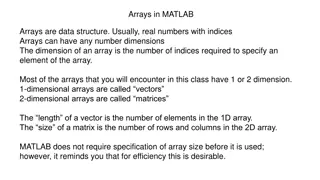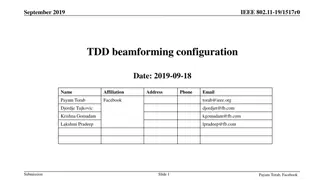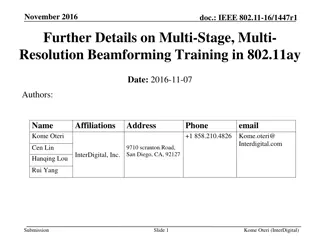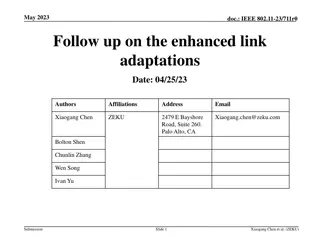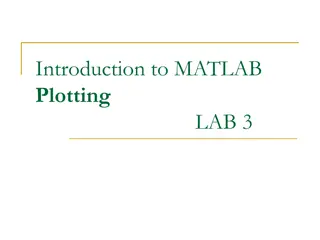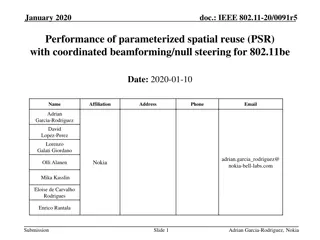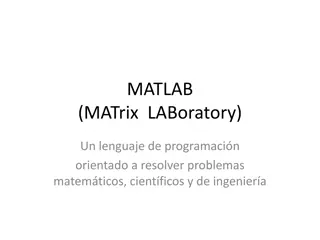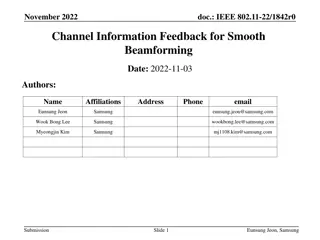Introduction to Microphone Array Beamforming: MATLAB Tutorial Series
"Explore microphone array beamforming techniques in this MATLAB tutorial series by Pouyan Ebrahimbabaie from the Laboratory for Signal and Image Exploitation at the University of Liège, Belgium. Learn about acoustic array geometry, signal processing, time-delay beamforming, and more to enhance audio techniques. Discover how to process sound signals from a microphone array, apply corrections, filter, and analyze the output with and without beamforming."
Download Presentation

Please find below an Image/Link to download the presentation.
The content on the website is provided AS IS for your information and personal use only. It may not be sold, licensed, or shared on other websites without obtaining consent from the author.If you encounter any issues during the download, it is possible that the publisher has removed the file from their server.
You are allowed to download the files provided on this website for personal or commercial use, subject to the condition that they are used lawfully. All files are the property of their respective owners.
The content on the website is provided AS IS for your information and personal use only. It may not be sold, licensed, or shared on other websites without obtaining consent from the author.
E N D
Presentation Transcript
Microphone array beamforming MATLAB tutorial series (Part 1) Pouyan Ebrahimbabaie Laboratory for Signal and Image Exploitation (INTELSIG) Dept. of Electrical Engineering and Computer Science University of Li ge Li ge, Belgium Introduction to audio and video techniques (ELEN0002-2) November 2020
Contacts Email: P.Ebrahimbabaie@ulg.ac.be Office: R81 a Tel: +32 (0) 436 66 37 53 Web: http://www.montefiore.ulg.ac.be/ ~ebrahimbabaie/ 2
? ? Mic 1 Mic 16
? ? Mic 1 Mic 16 0.07 m
? Sound source Azimuth: ? Elevation: ? ? Mic 1 Mic 16 0.07 m
? ? 0.07 m
Voice Azimuth: 90 Elevation: 0 ? Noise source Azimuth: 180 Elevation: 0 0.07 m
? 16 x mic. Sound card 16 x .wav Read 16 x .wav s into a single matrix sigArray (N x 16) sigArray (N x 16) Multiply each column by its corresponding correction coefficient Corrected sigArray Filter sigArray with a bandpass filter (300 Hz 3400 Hz) Filtered sigArray Play an arbitrary column Apply time-delay beamforming on sigArray Play the output signal Output signal (N x 1) Compare two signals (with and without beamforming)
? 16 x mic. Sound card 16 x .wav Read 16 x .wav s into a single matrix sigArray (N x 16) sigArray (N x 16) Multiply each column by its corresponding correction coefficient Corrected sigArray Filter sigArray with a bandpass filter (300 Hz 3400 Hz) Filtered sigArray Play an arbitrary column Apply time-delay beamforming on sigArray Play the output signal Output signal (N x 1) Compare two signals (with and without beamforming)
? 16 x mic. Sound card 16 x .wav Read 16 x .wav s into a single matrix sigArray (N x 16) sigArray (N x 16) Multiply each column by its corresponding correction coefficient Corrected sigArray Filter sigArray with a bandpass filter (300 Hz 3400 Hz) Filtered sigArray Play an arbitrary column Apply time-delay beamforming on sigArray Play the output signal Output signal (N x 1) Compare two signals (with and without beamforming)
? 16 x mic. Sound card 16 x .wav Read 16 x .wav s into a single matrix sigArray (N x 16) sigArray (N x 16) Multiply each column by its corresponding correction coefficient Corrected sigArray Filter sigArray with a bandpass filter (300 Hz 3400 Hz) Filtered sigArray Play an arbitrary column Apply time-delay beamforming on sigArray Play the output signal Output signal (N x 1) Compare two signals (with and without beamforming)
? 16 x mic. Sound card 16 x .wav Read 16 x .wav s into a single matrix sigArray (N x 16) sigArray (N x 16) Multiply each column by its corresponding correction coefficient Corrected sigArray Filter sigArray with a bandpass filter (300 Hz 3400 Hz) Filtered sigArray Play an arbitrary column Apply time-delay beamforming on sigArray Play the output signal Output signal (N x 1) Compare two signals (with and without beamforming)
? 16 x mic. Sound card 16 x .wav Read 16 x .wav s into a single matrix sigArray (N x 16) sigArray (N x 16) Multiply each column by its corresponding correction coefficient Corrected sigArray Filter sigArray with a bandpass filter (300 Hz 3400 Hz) Filtered sigArray Play an arbitrary column Apply time-delay beamforming on sigArray Play the output signal Output signal (N x 1) Compare two signals (with and without beamforming)
? 16 x mic. Sound card 16 x .wav Read 16 x .wav s into a single matrix sigArray (N x 16) sigArray (N x 16) Multiply each column by its corresponding correction coefficient Corrected sigArray Filter sigArray with a bandpass filter (300 Hz 3400 Hz) Filtered sigArray Play an arbitrary column Apply time-delay beamforming on sigArray Play the output signal Output signal (N x 1) Compare two signals (with and without beamforming)
Part 2: finding the DOA Not included for 2020!
? Sound source Azimuth: ? Elevation: 0 Direction Of Arrival: ? ? 0.07 m
? Steer angle Azimuth: 90 Elevation: 0
? Steer angle Azimuth: 180 Elevation: 0
? Steer angle Azimuth: -30 Elevation: 0
Useful links https://nl.mathworks.com/help/phase d/ug/acoustic-beamforming-using-a- microphone-array.html https://nl.mathworks.com/help/phase d/direction-of-arrival-doa-estimation- 1.html https://people.montefiore.uliege.be/e brahimbabaie/applieddigtial_fichiers/ TPS/TP2/Final/Slides/Powerline%20n oise%20elimination.pdf 27




